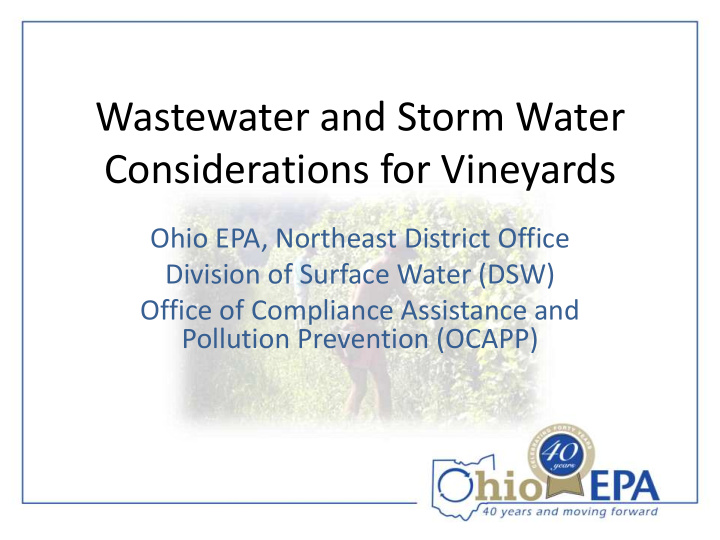



Wastewater and Storm Water Considerations for Vineyards Ohio EPA, Northeast District Office Division of Surface Water (DSW) Office of Compliance Assistance and Pollution Prevention (OCAPP)
Ohio EPA Northeast District Office is at 2110 East Aurora Rd. (State Route 82 1 mi W of I-480) Twinsburg, OH 44087 (330) 963-1200 phone (330) 487-0769 fax
Coordination with Ohio EPA DSW • Land Application of Residuals • Land Development (Construction) • Wetland Impacts • Onsite Wastewater Treatment • Storm Water Considerations
Land Application of Residuals • Not required for residuals that never leave the field • Required if making wine or spirits and land applying • Requires a Holding Tank (PTI) • Land Application Management Plan (LAMP) for liquids, solids
Land Development - Construction • Construction Storm Water Permit – Notice of Intent (NOI) – Excludes Vineyard Development • Required if Development > 1 ac • Storm Water Pollution Prevention Plan (SWPPP) • Ohio EPA Guidance – http://epa.ohio.gov/dsw/storm/index.aspx
Impacting Wetlands • U.S. Army Corps of Engineers – Jurisdictional Determination – Determines if Corps or Ohio EPA Permit is Required • Filling Wetland – Allowable fill area depends on wetland class (1,2,3) • Public Notice and Hearings – May add substantial time • Ohio EPA Guidance – http://epa.ohio.gov/dsw/401/index.aspx
Sanitary Sewage System
What to Do First… • Speak to a Wastewater Design Engineer – Ohio EPA cannot recommend a specific PE – Ohio EPA requires PTI, Health Depts. vary – PTIs must be prepared by an Ohio Professional Engineer (PE) – Soils in many Ohio Counties have limited suitability for onsite disposal – Discuss Site Plans, Short Term and Long Term
Soil Evaluations • Design Engineer typically works with a specific Qualified Soil Scientist • Determines Onsite Soil Limiting Conditions • Form B-13 Online: – http://epa.ohio.gov/dsw/pti/index.aspx
Site Evaluation • Identifies all Waste Water Sources – Also include Proposed Menu – Forms Online: http://epa.ohio.gov/dsw/pti/index.aspx • Establishes Sewage Design Flow – Ohio Admin Code 3745-42-05 – Think Long Term > 5 years – Design for maximum flow
Design Flow Considerations • Average Daily Design Flow – Ohio Admin Code 3745-42-05 – Employees: 15 gallons/day – Wine Tasting with Limited/Prepackage Foods (No Food Prep): 5 gallons/day/seat – Restaurant or Tavern (Food Preparation): 30 gallons/day/seat, plus high strength waste water – Flow Equalization for Special Events – Consider Catered Events
Discharging vs. Onsite Systems Discharging Systems Onsite Systems • Requires Licensed Operator • Limited waste water Strengths, Flow Rates • Analytical Costs • Limited by Soils, Footprint • Discharge Permit • Lower O&M Costs • High Strength OK • No Operator, Analytical • Smaller Footprint • Preferred to Discharging • Must have Suitable Receiving Stream • Moratorium on some streams (Grand River)
PTI Application Process • Application(s) Received – Copies of Plans (4), Forms (2), Fees – Step-by-Step: http://epa.ohio.gov/dsw/pti/index, under “How to Obtain PTI” tab • District Review – Deficiency Letters sent to Engineer – Final Recommendation to Columbus • Authorization Issued – PTI Issued by Director
PTI Execution • Facility should have a contract with the Design Engineer to oversee construction and ensure conforms to PTI • Construction must start within 18 months
Storm Water Considerations • Commercial Wine Making – SIC Code 2084 • Subject to Industrial Storm Water – Storm Water Permit – No Exposure Certification • If Storm Water Permit Needed – Individual Permit – General Permit
Questions ? John M. Schmidt, P.E., R.S. Ohio EPA, Division of Surface Water 2110 East Aurora Road Twinsburg, OH 44087 (330) 963-1175
Recommend
More recommend